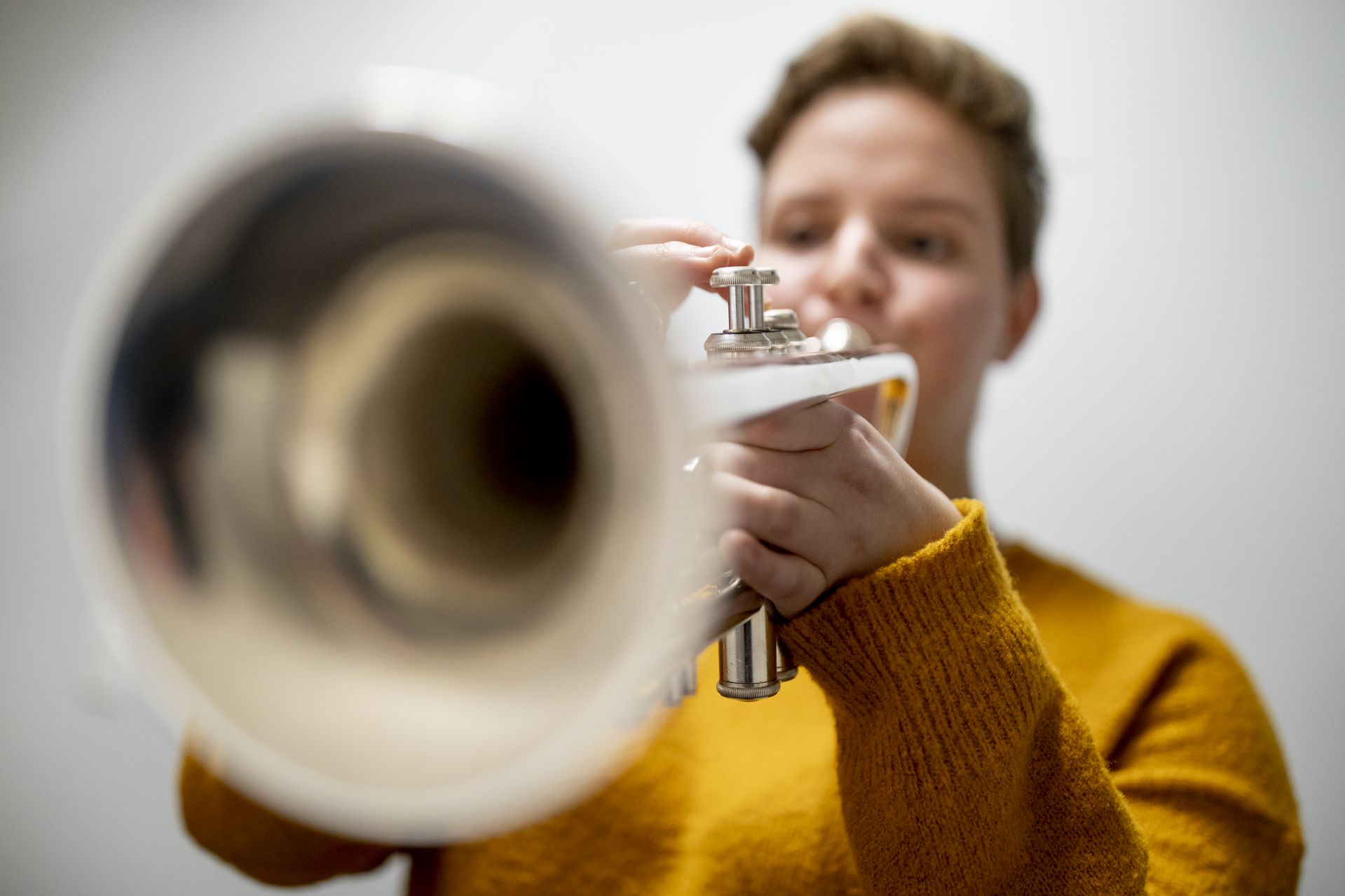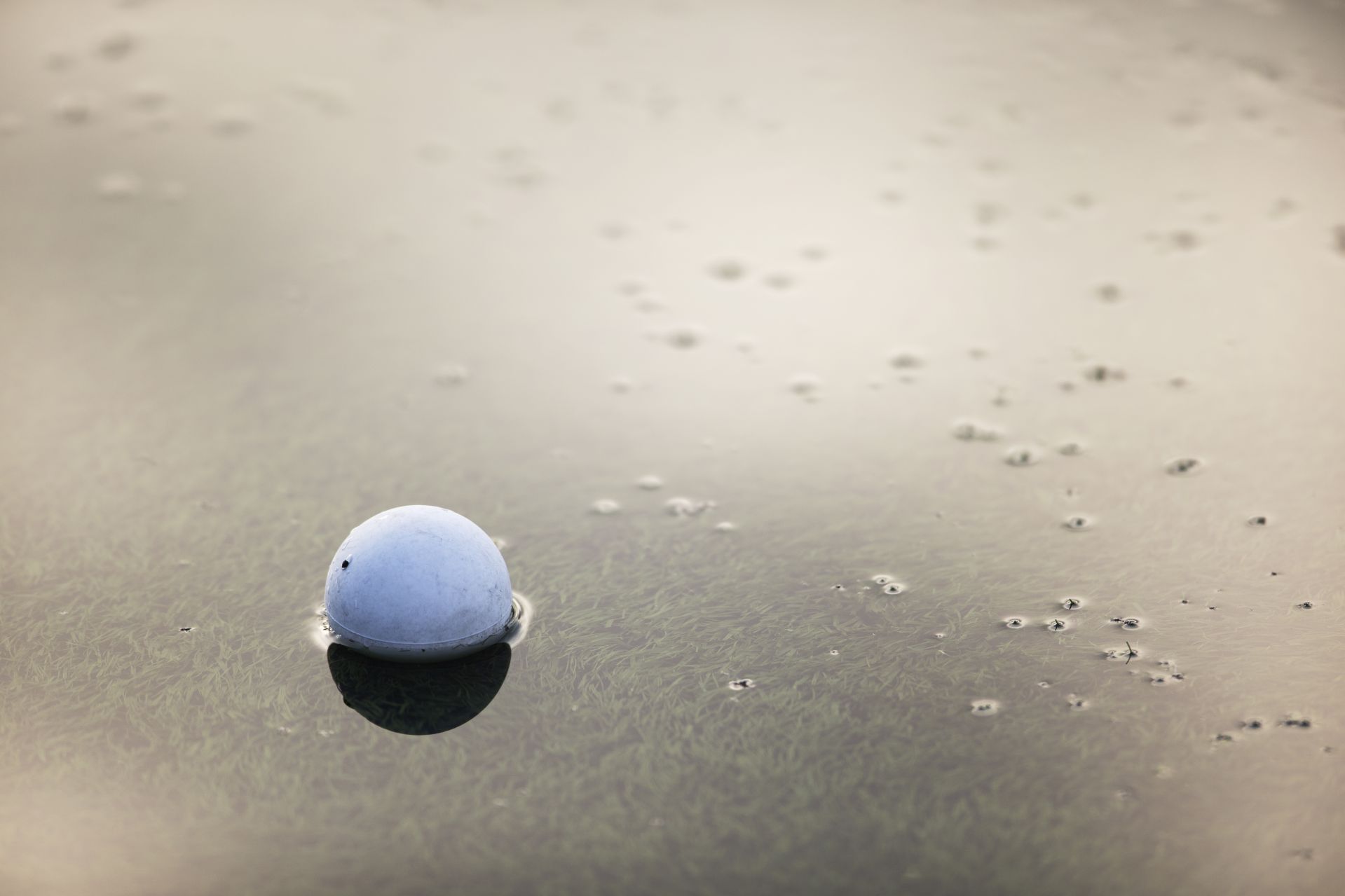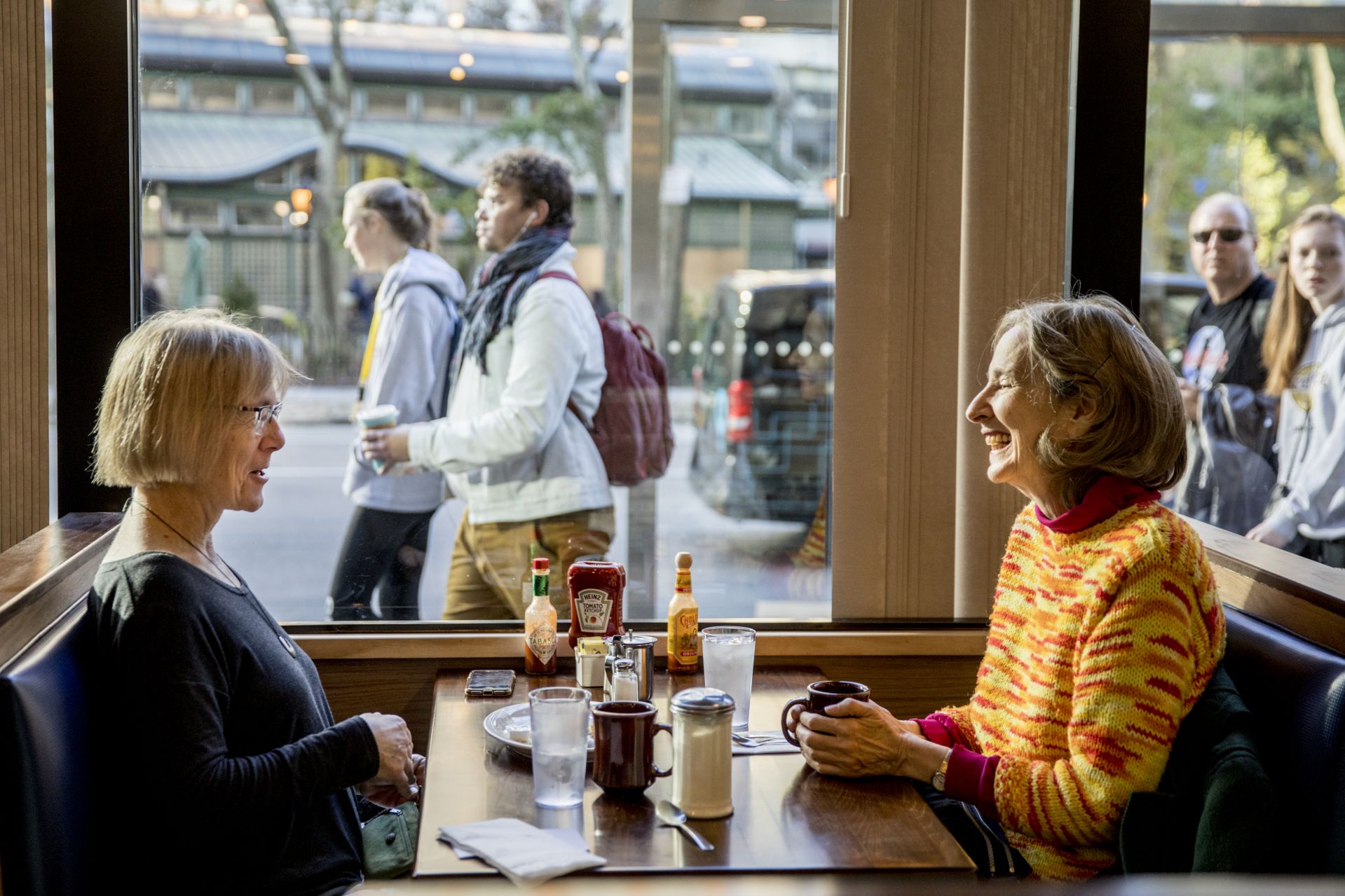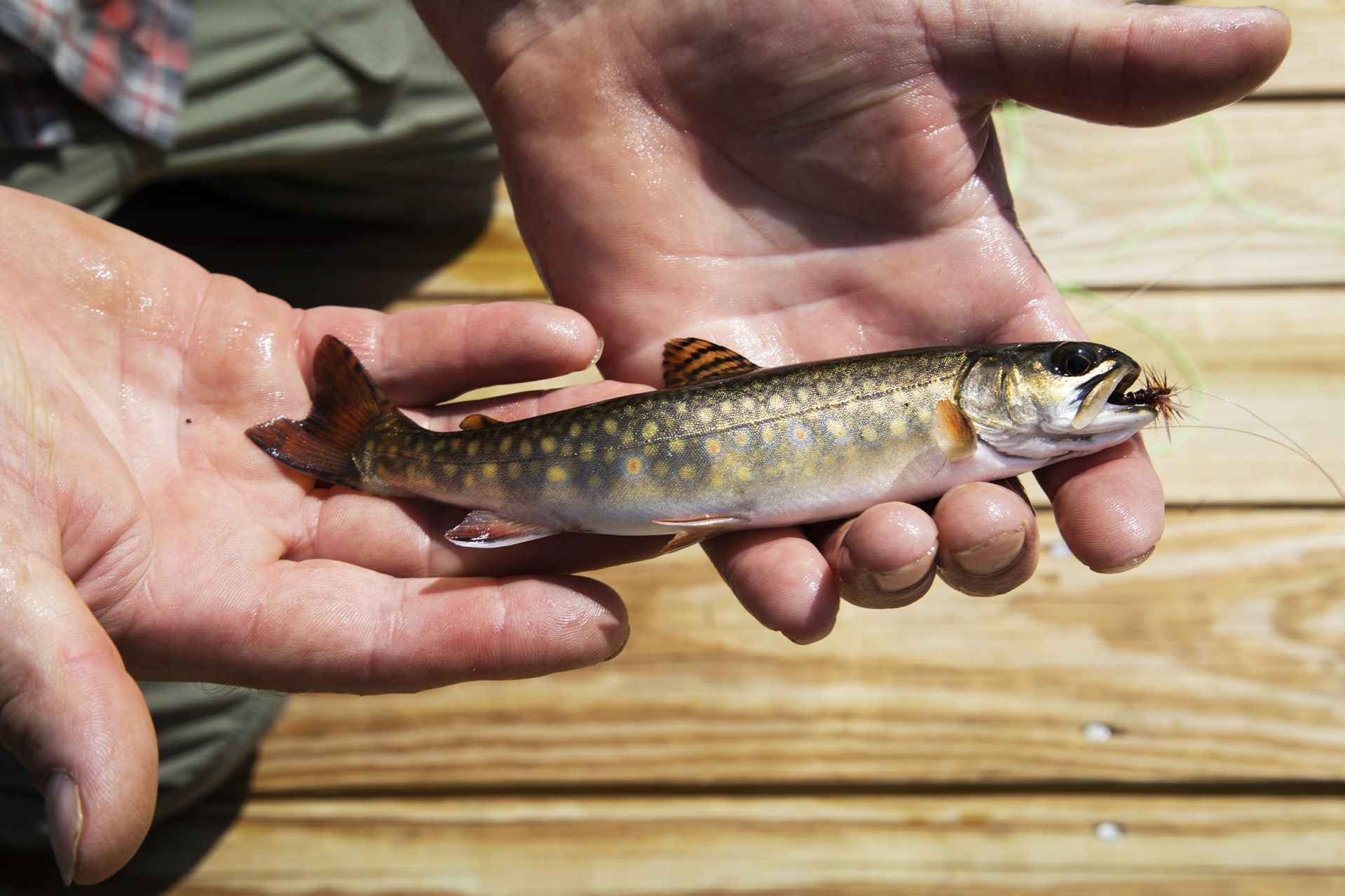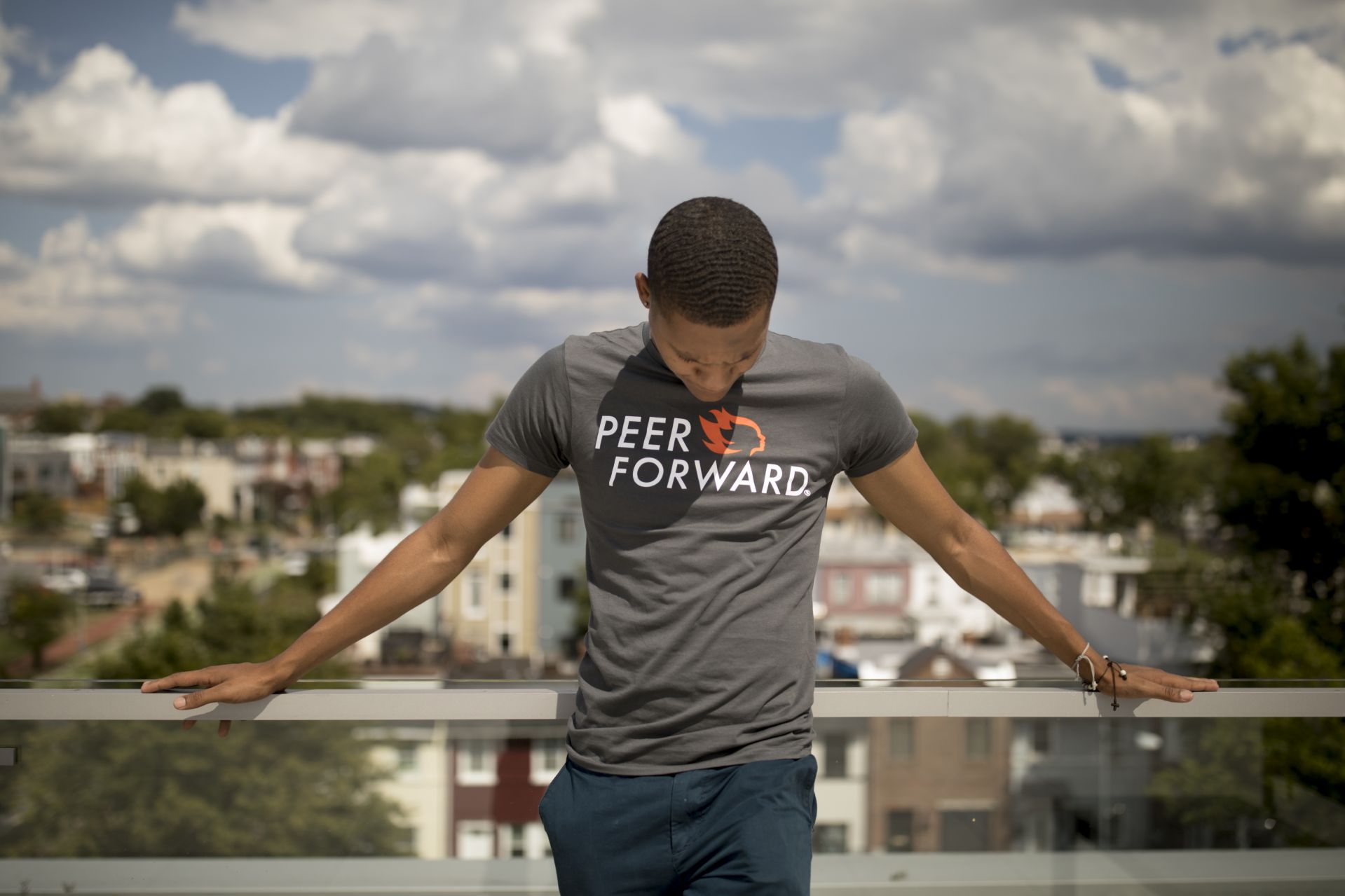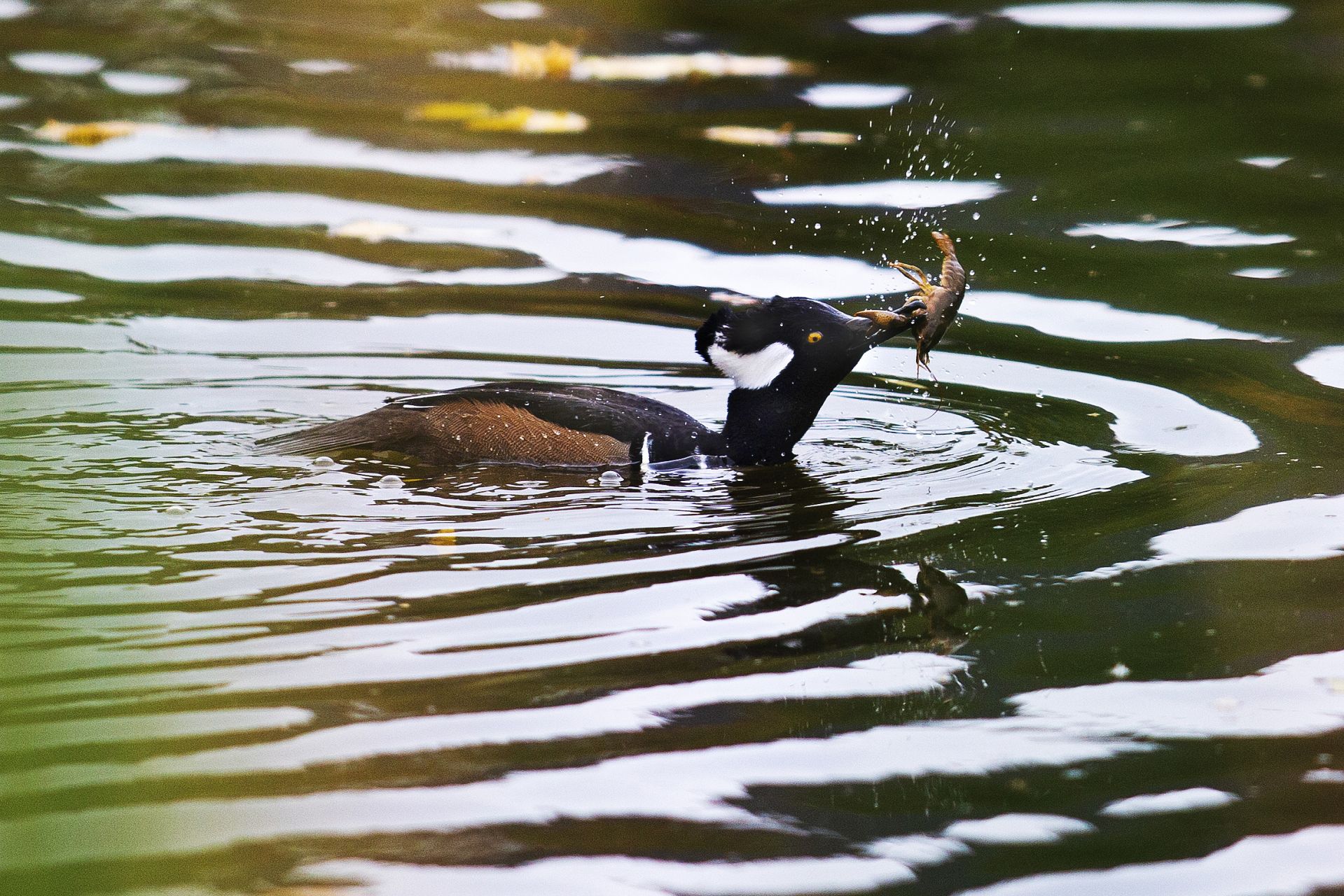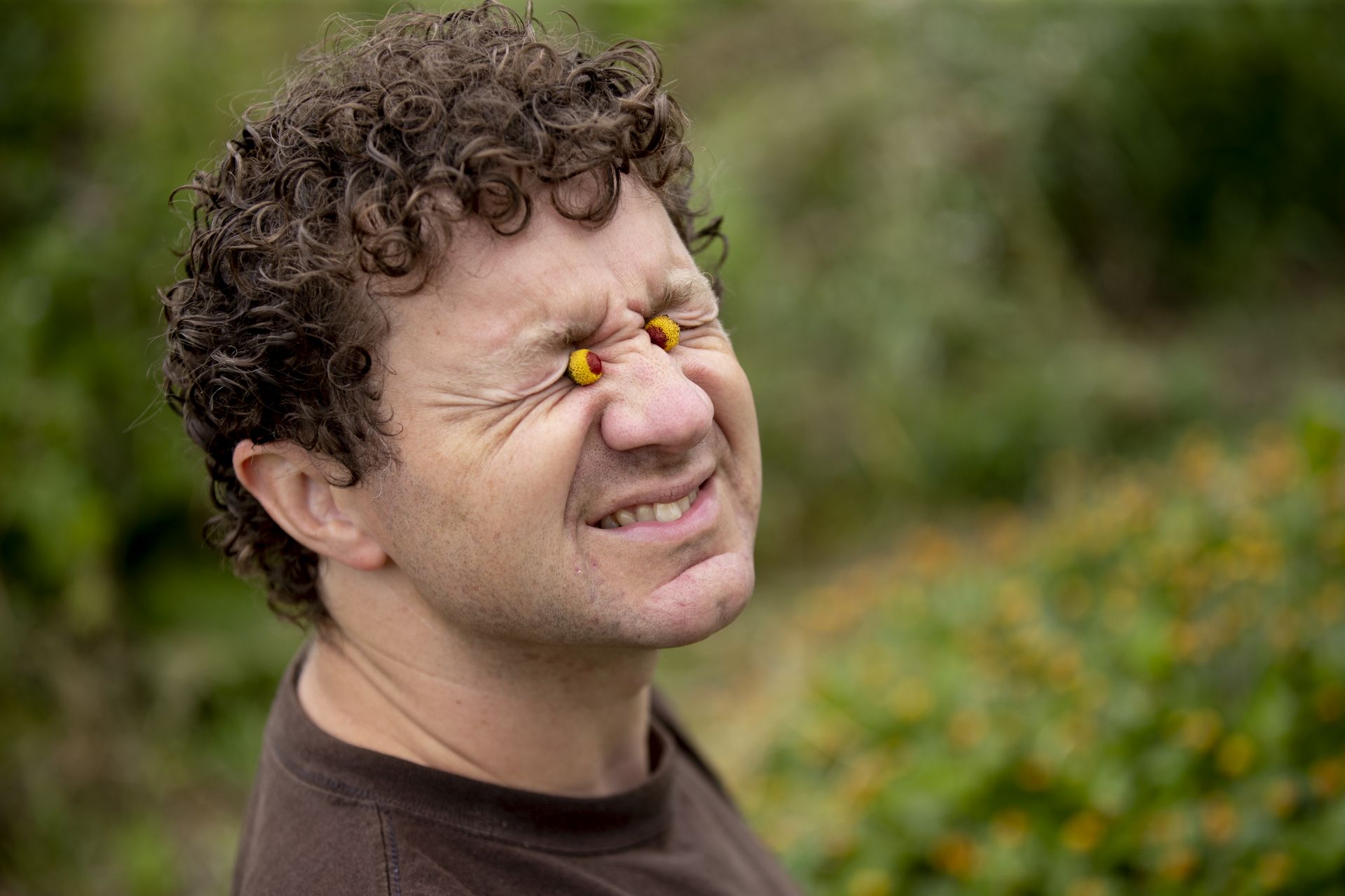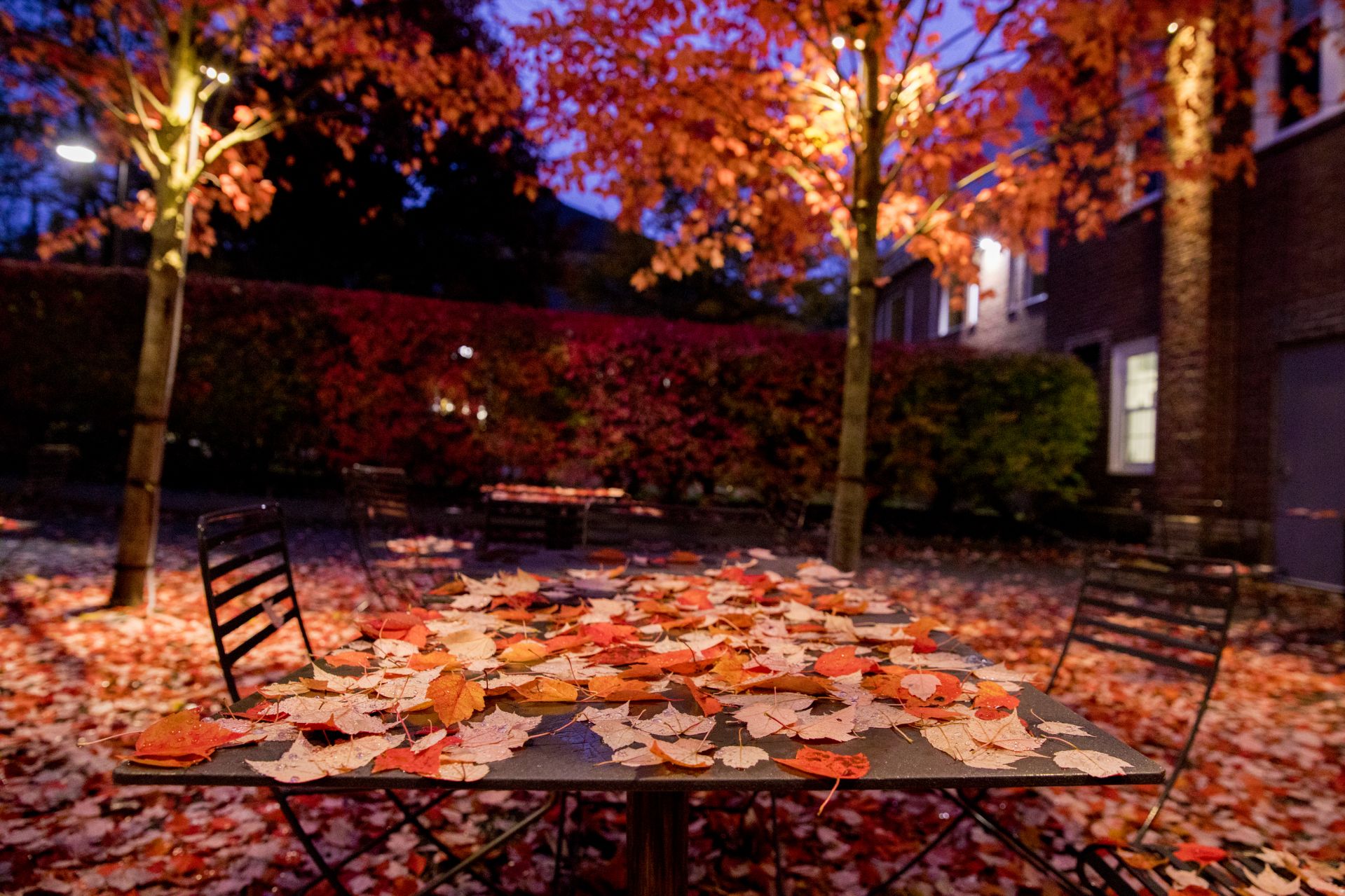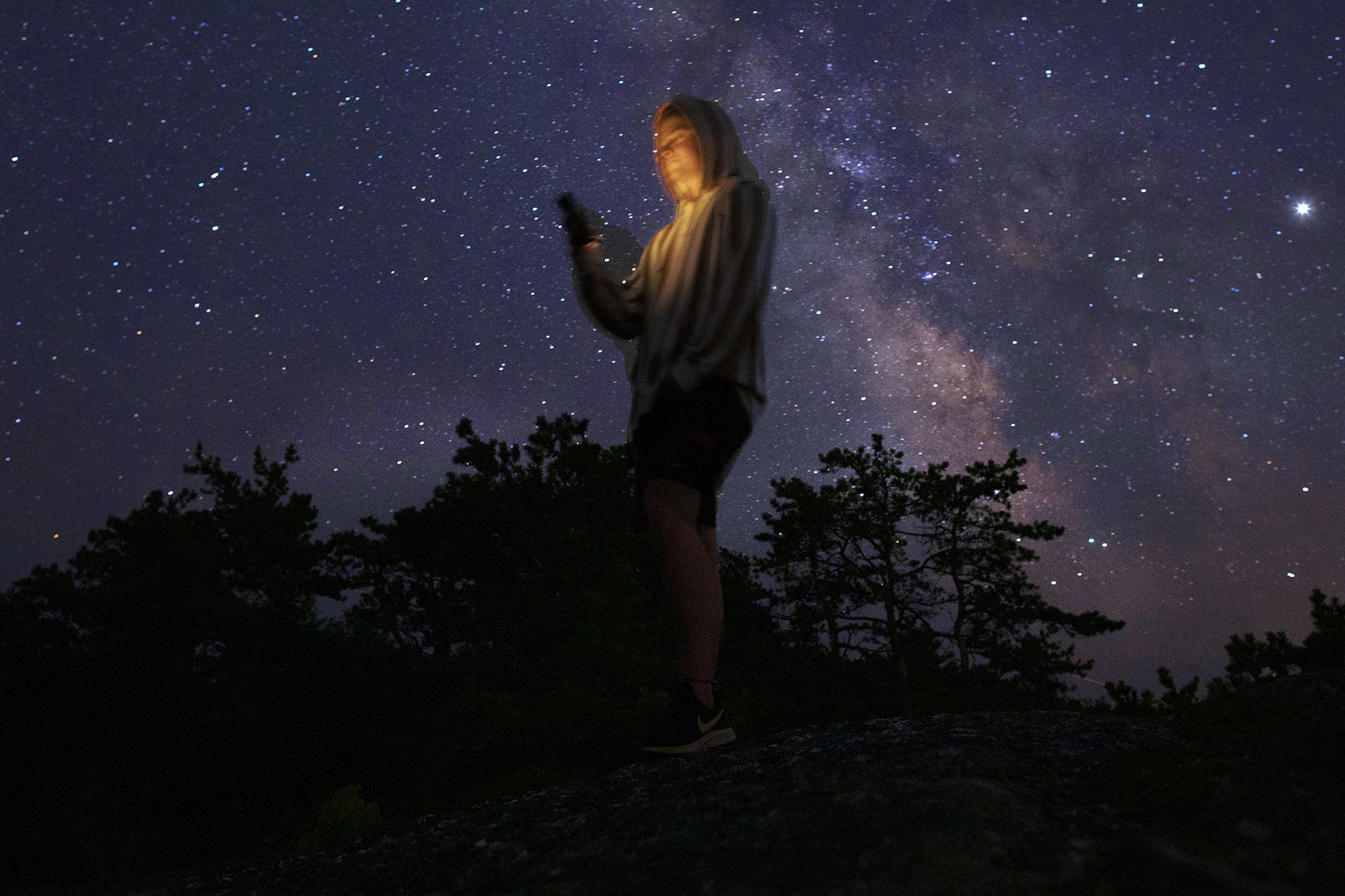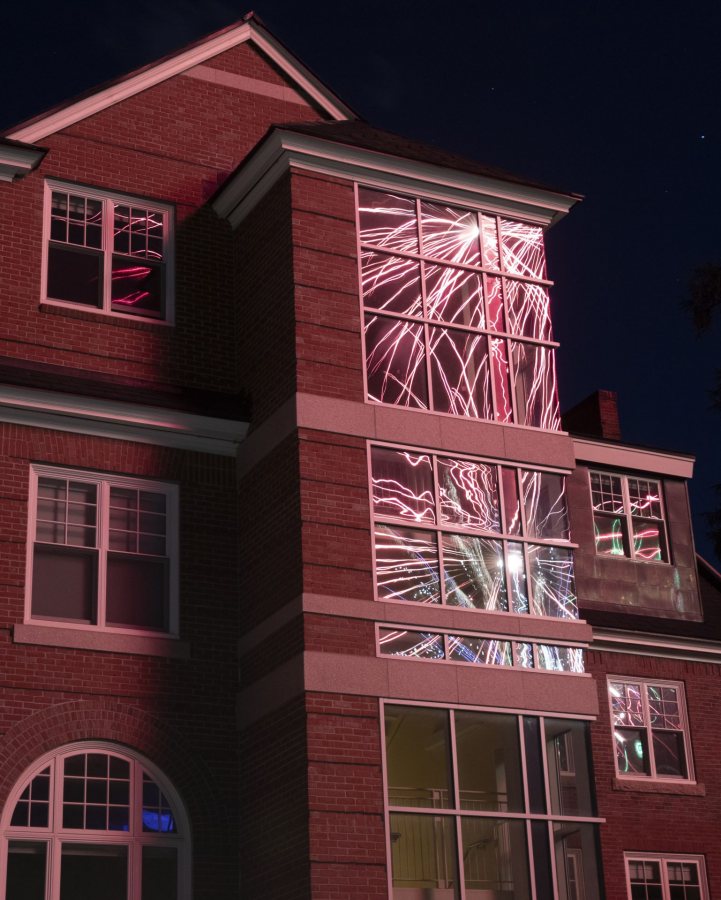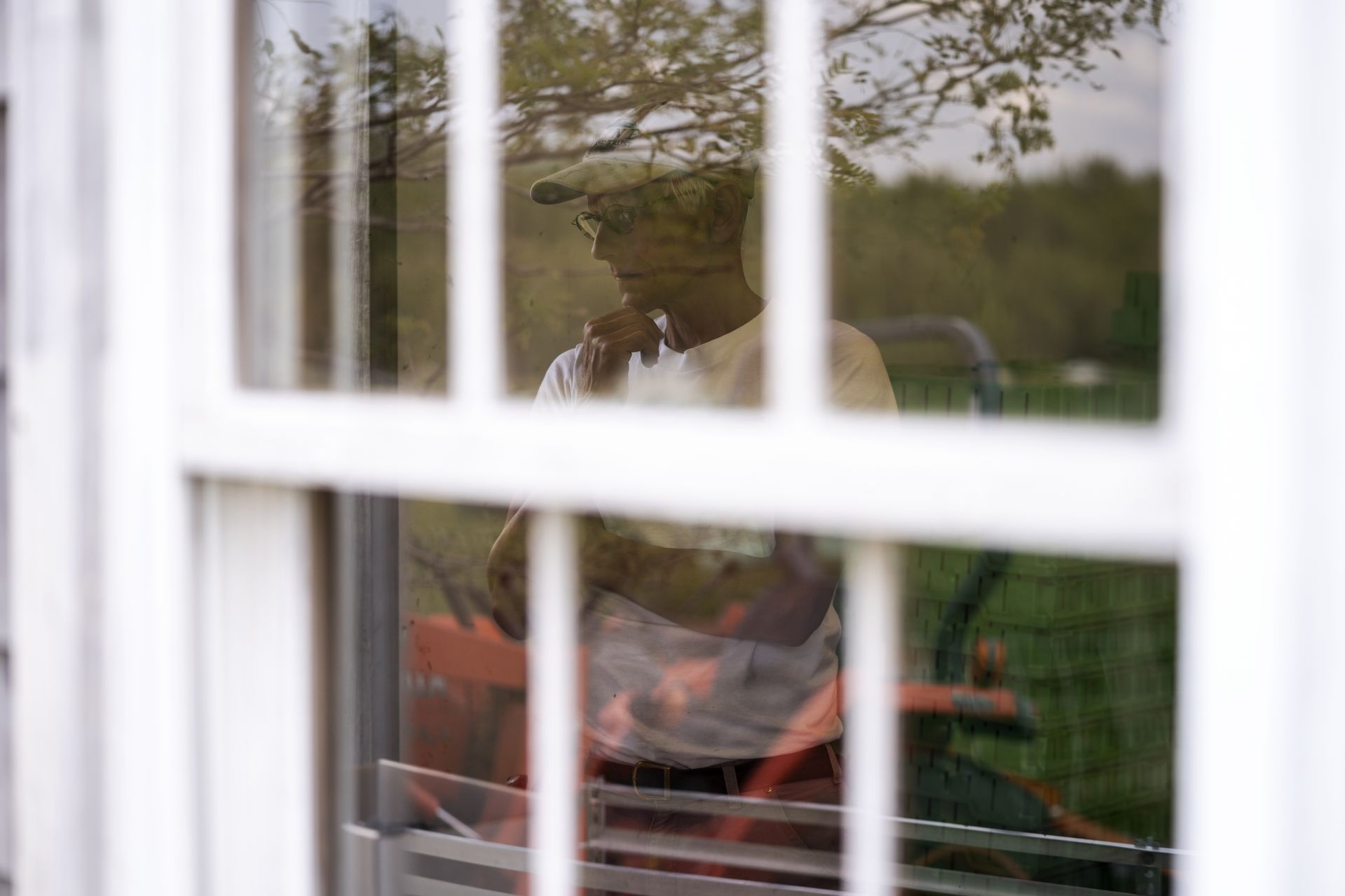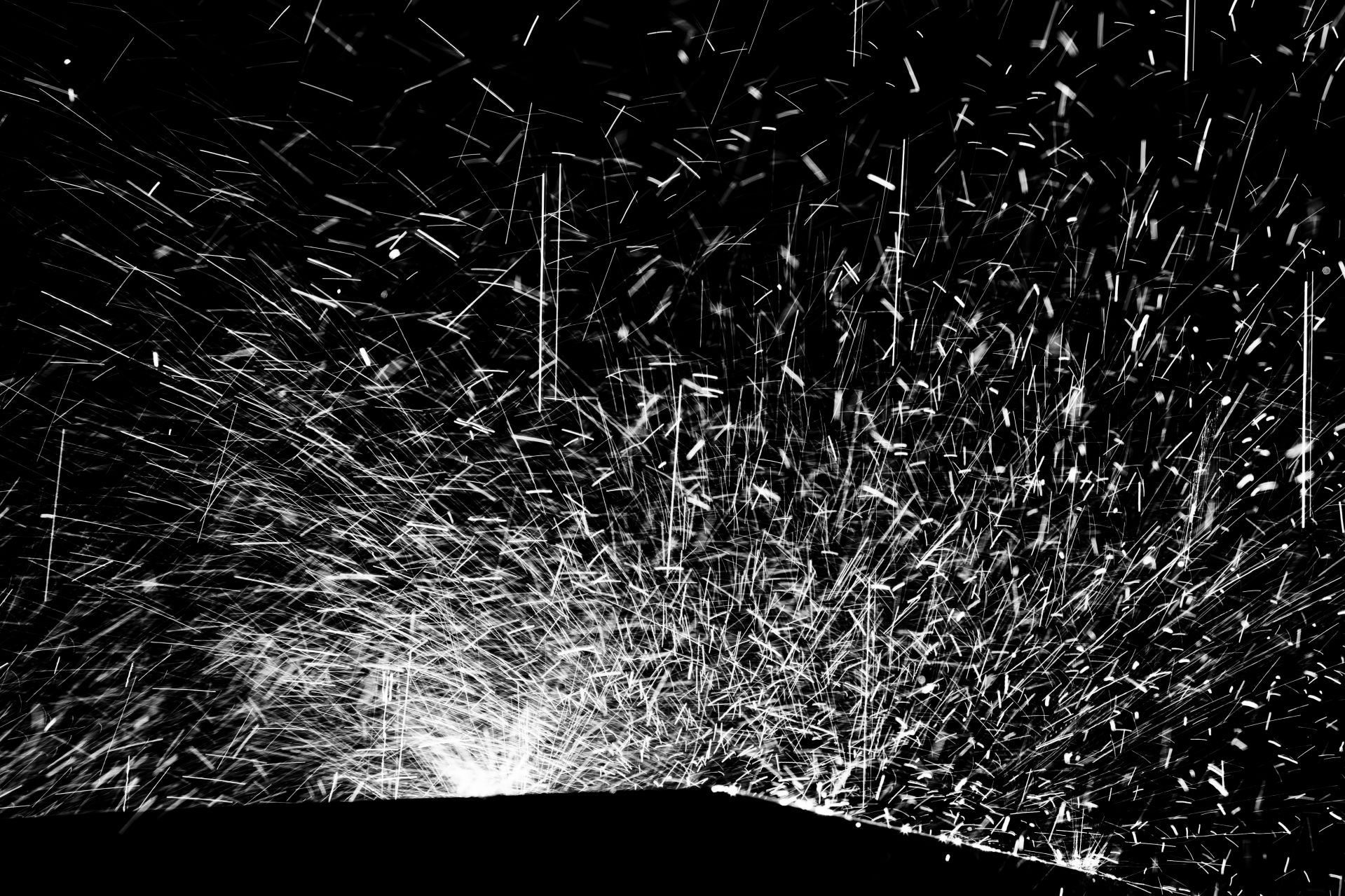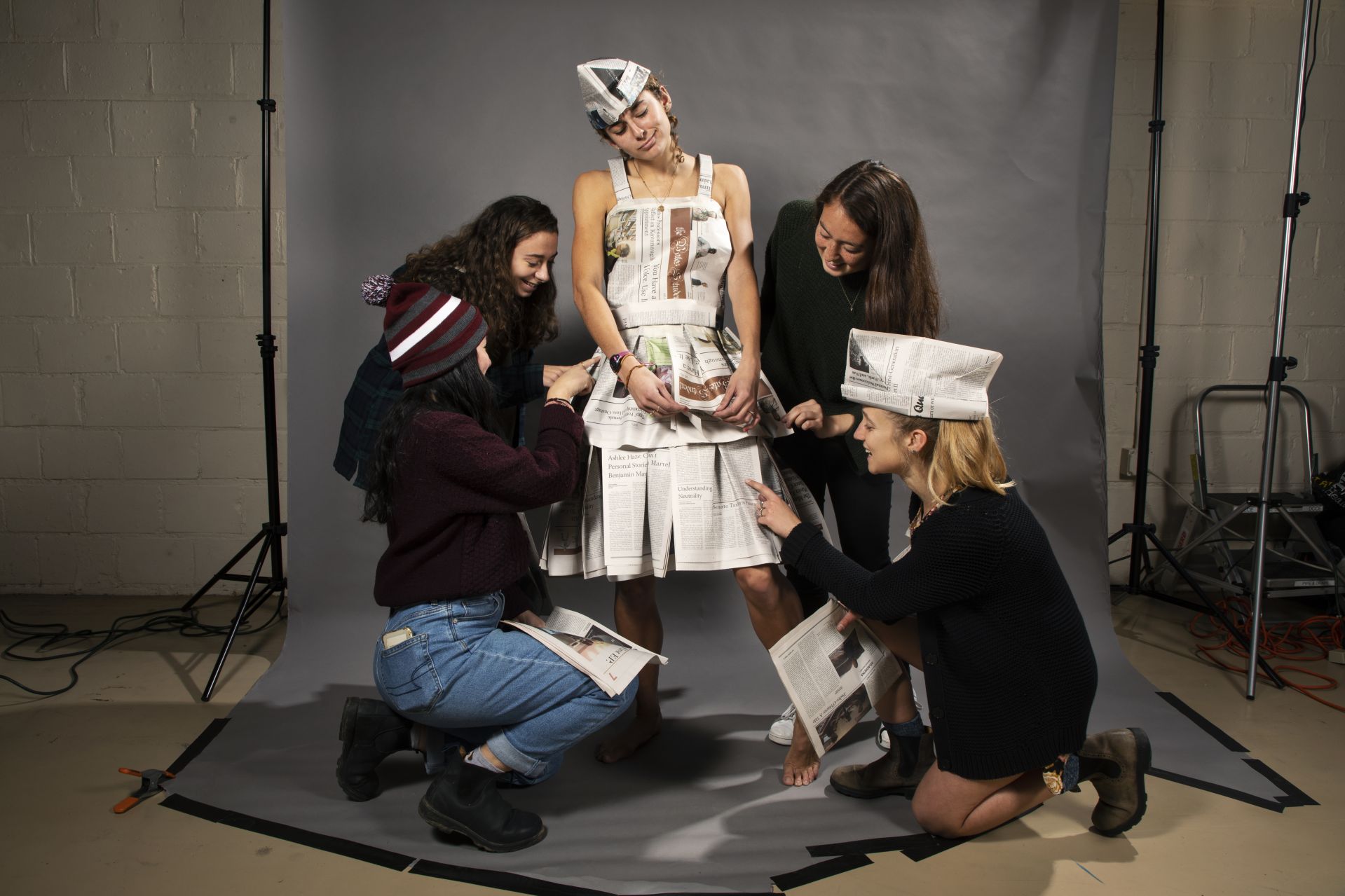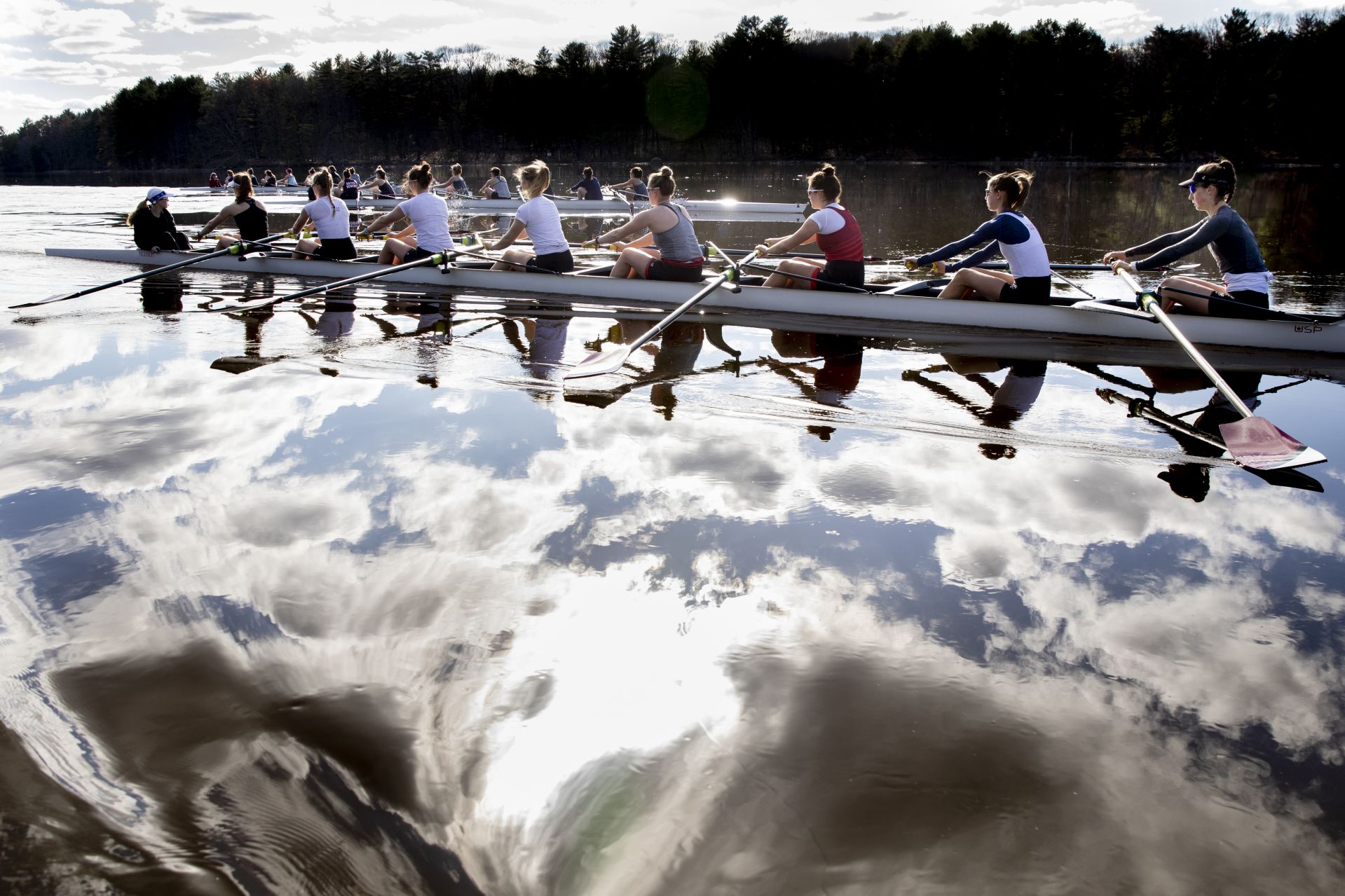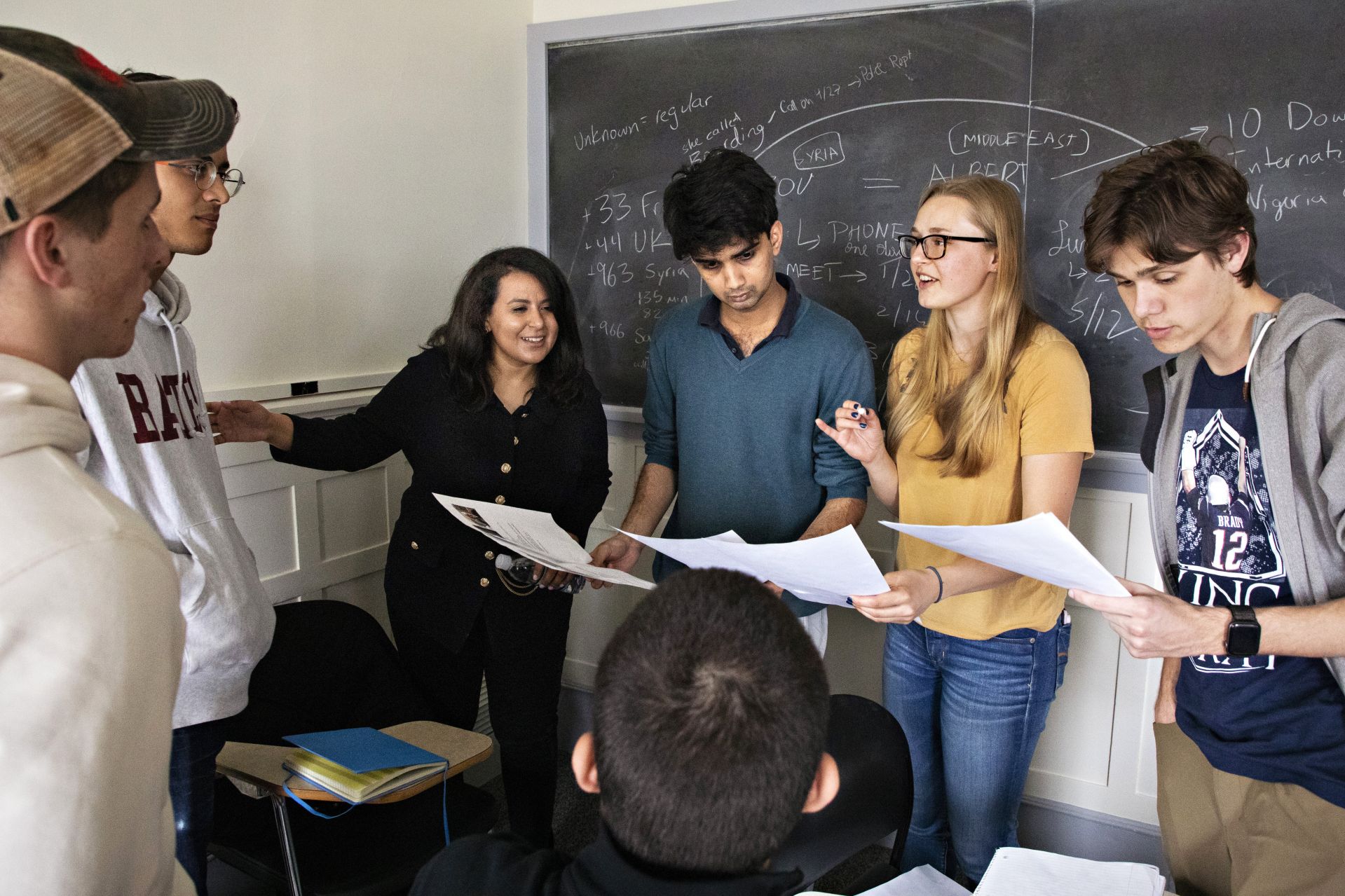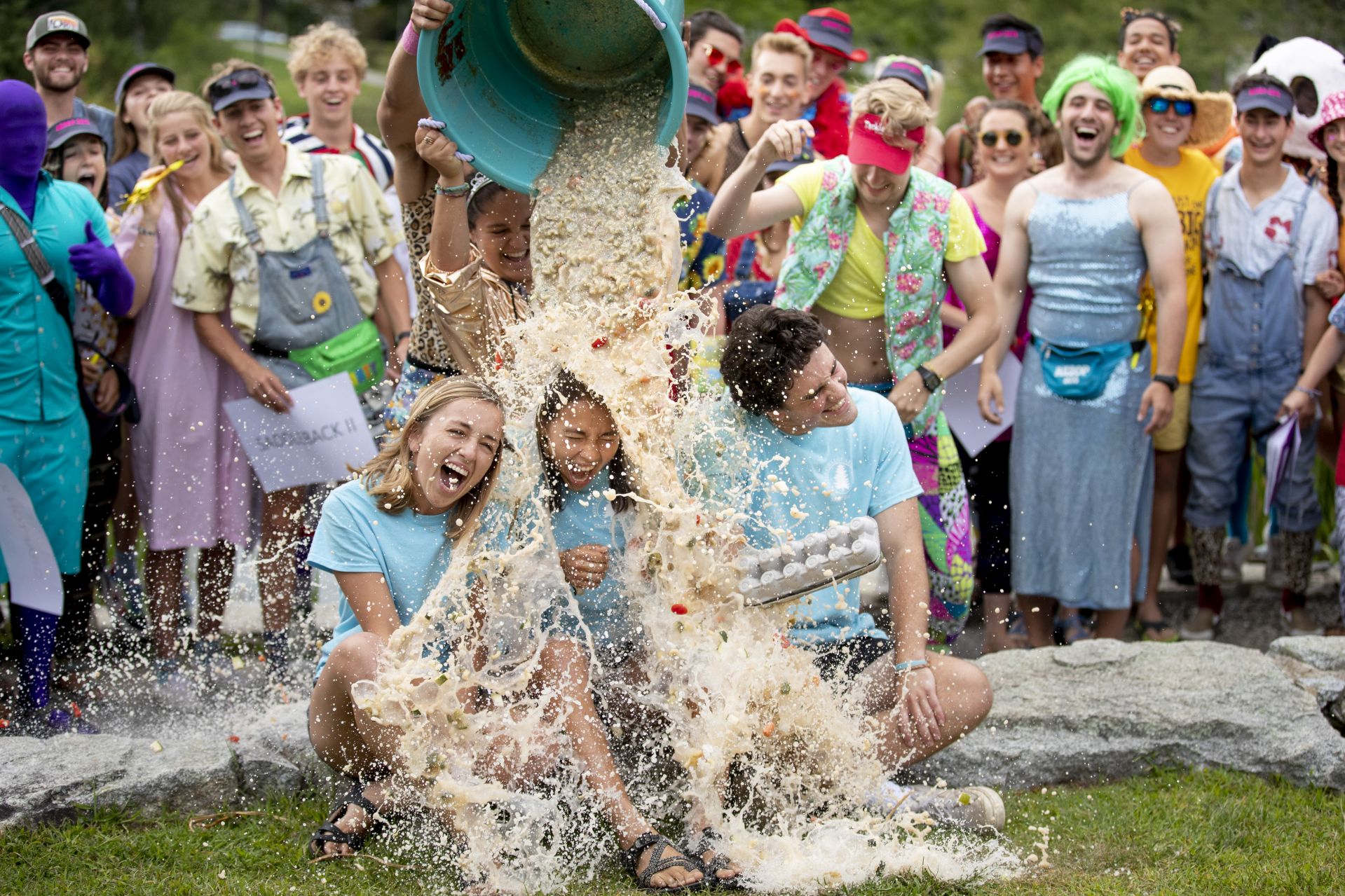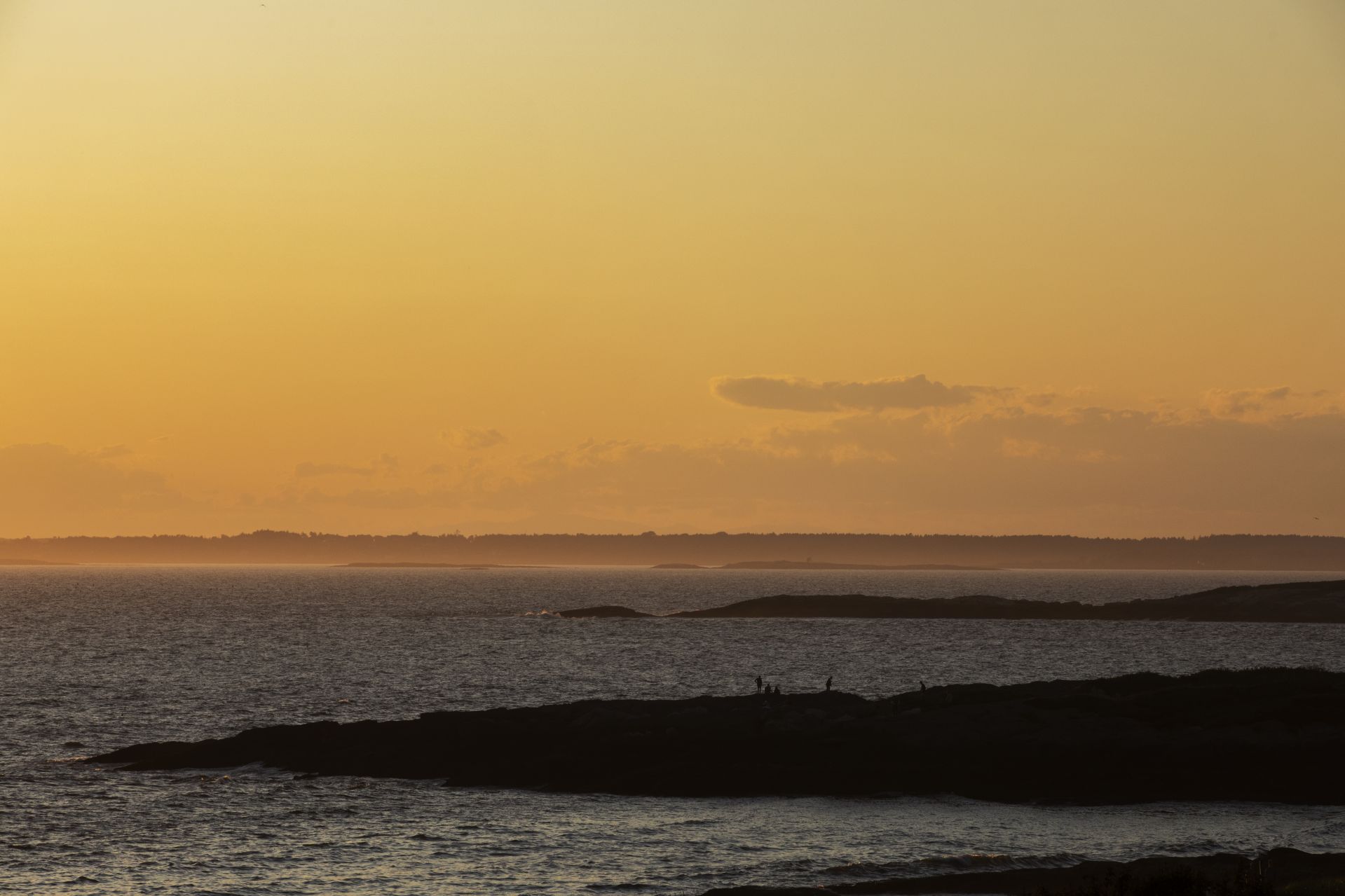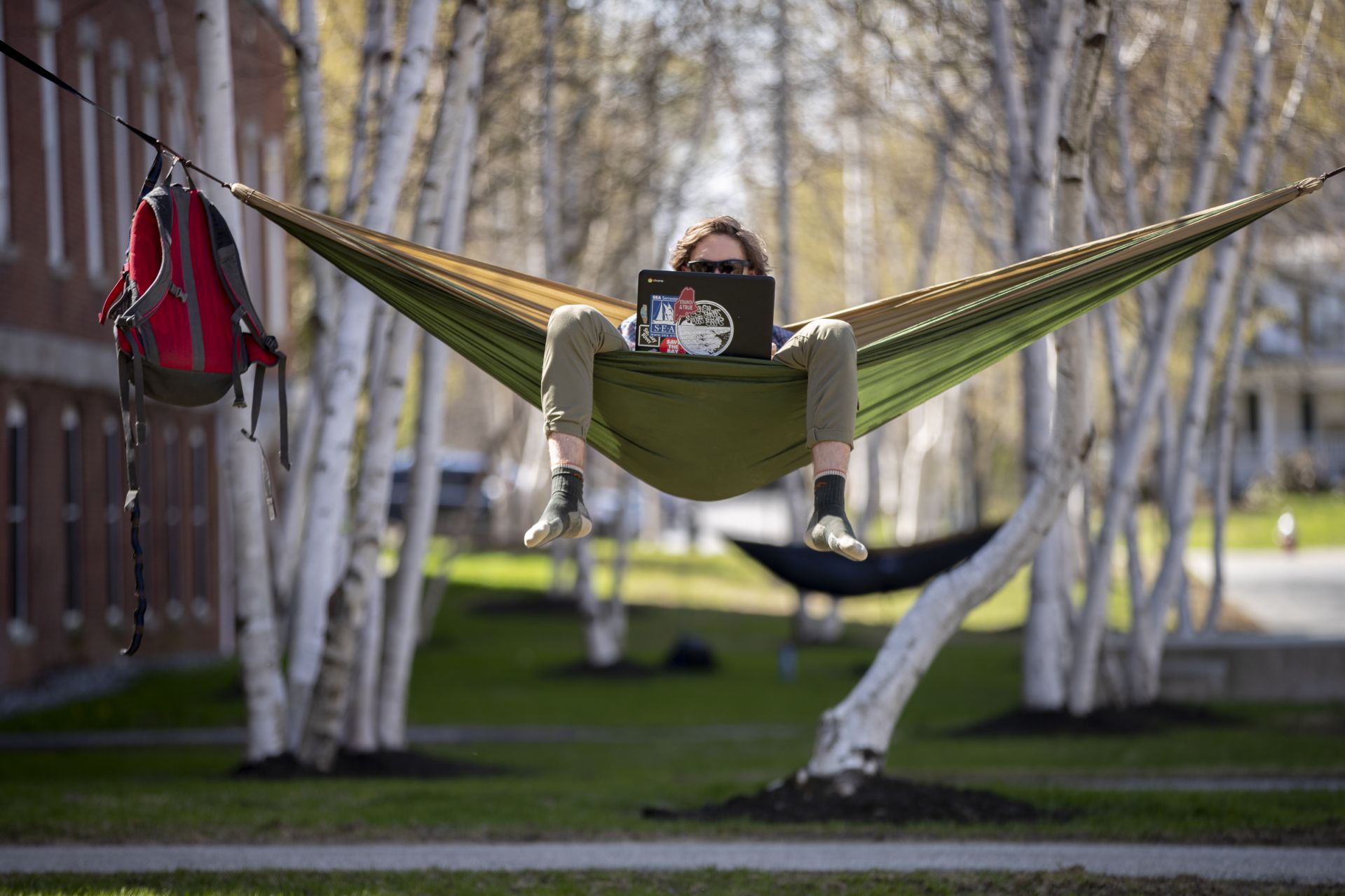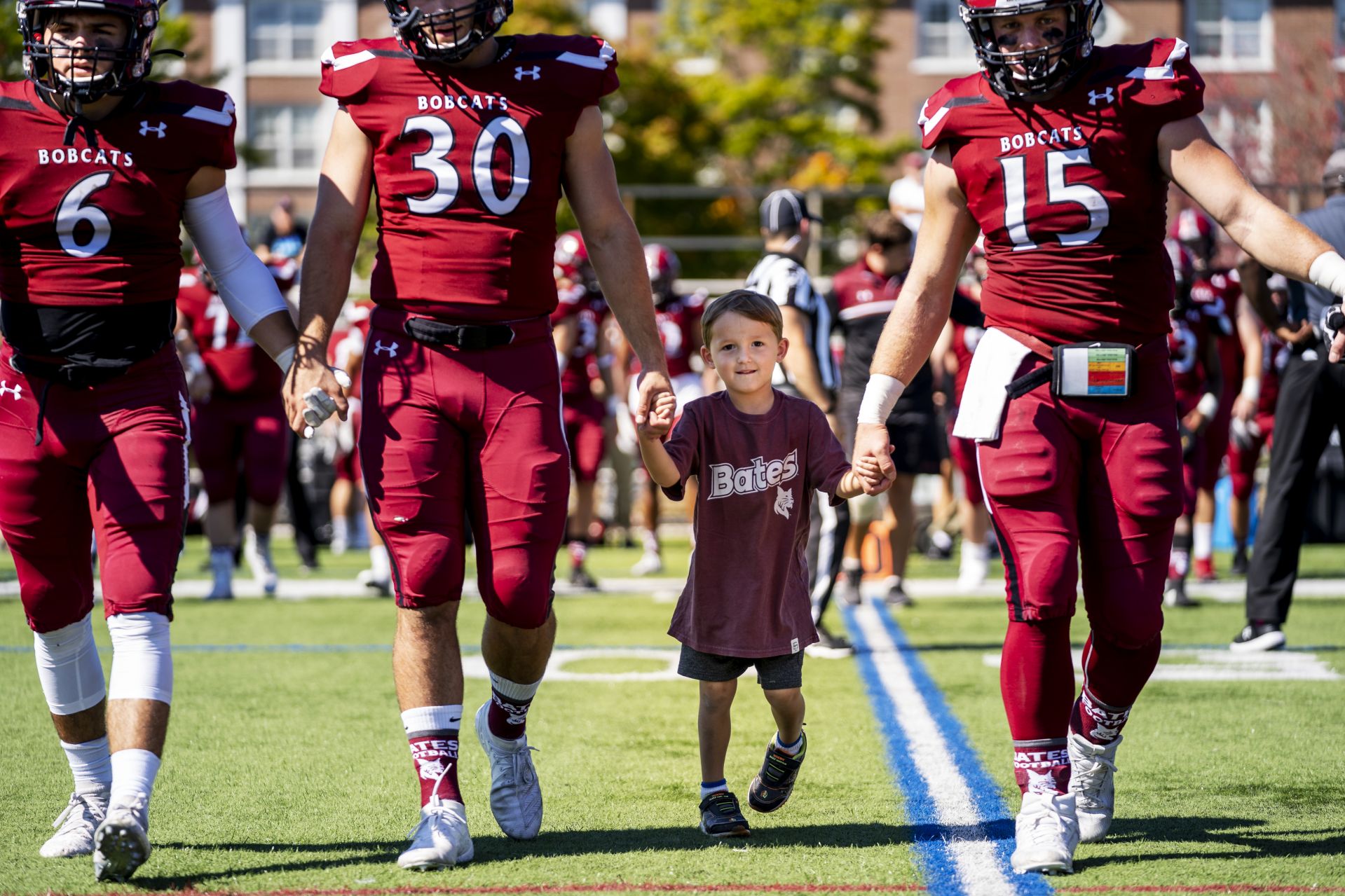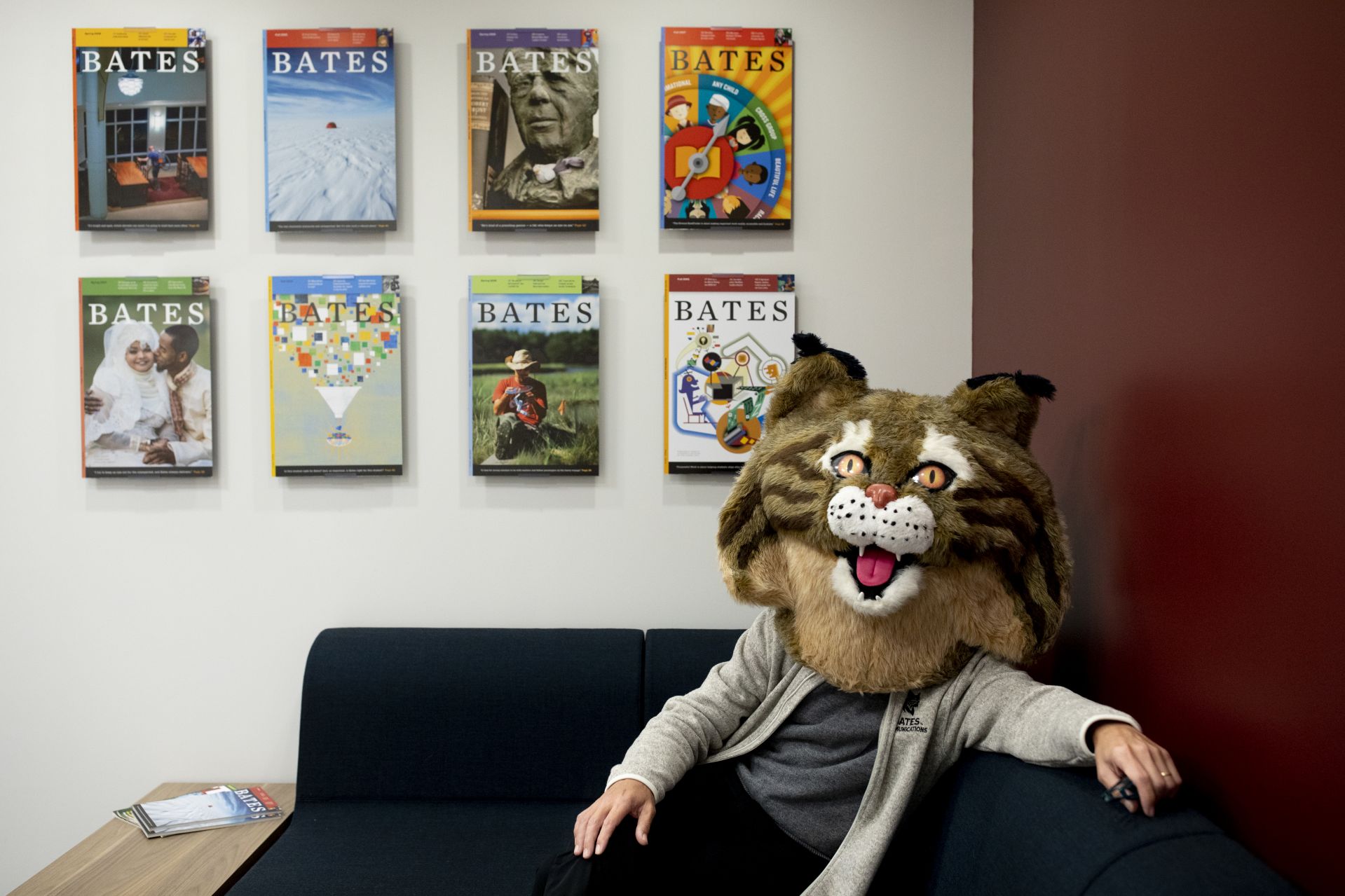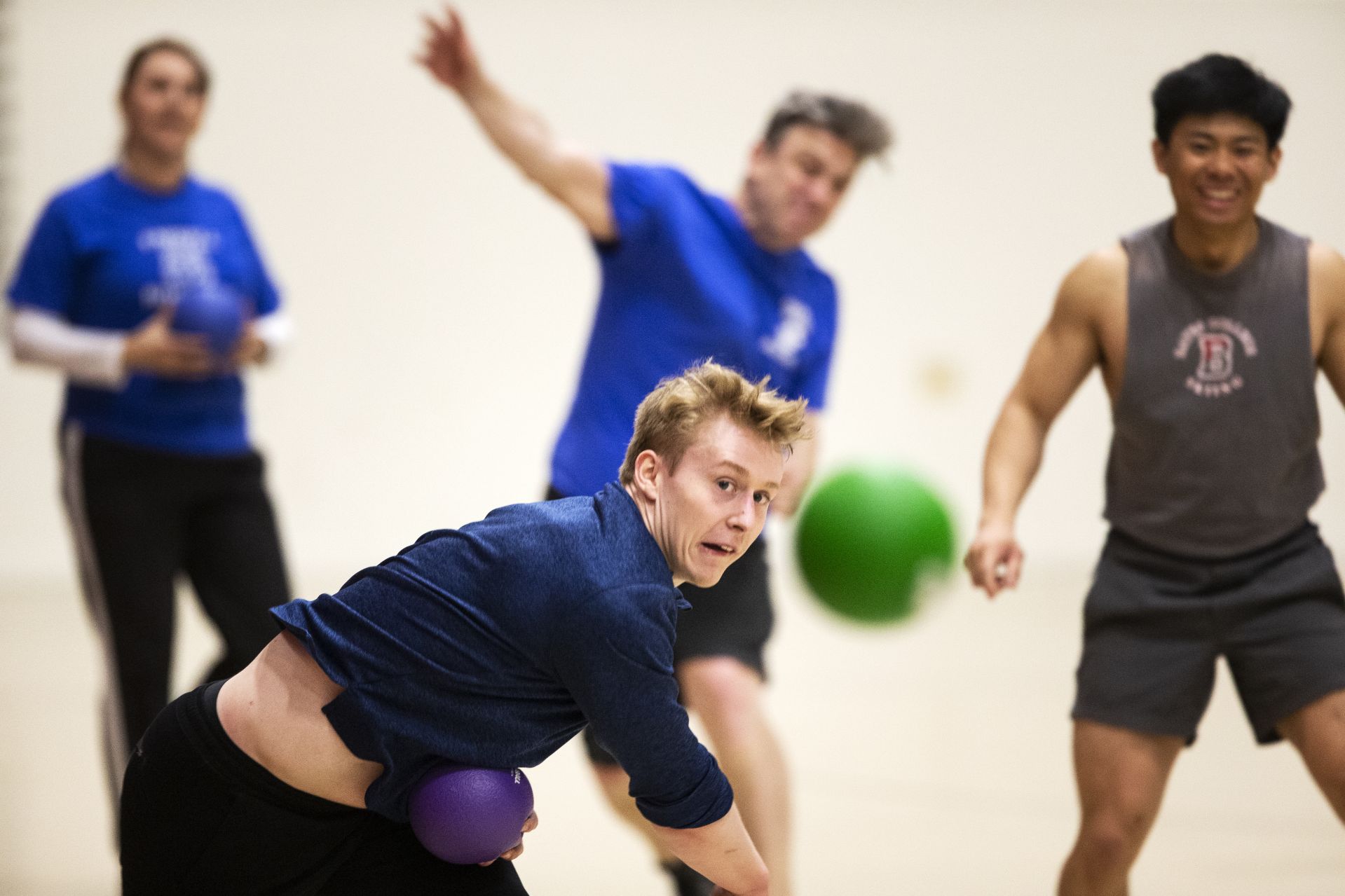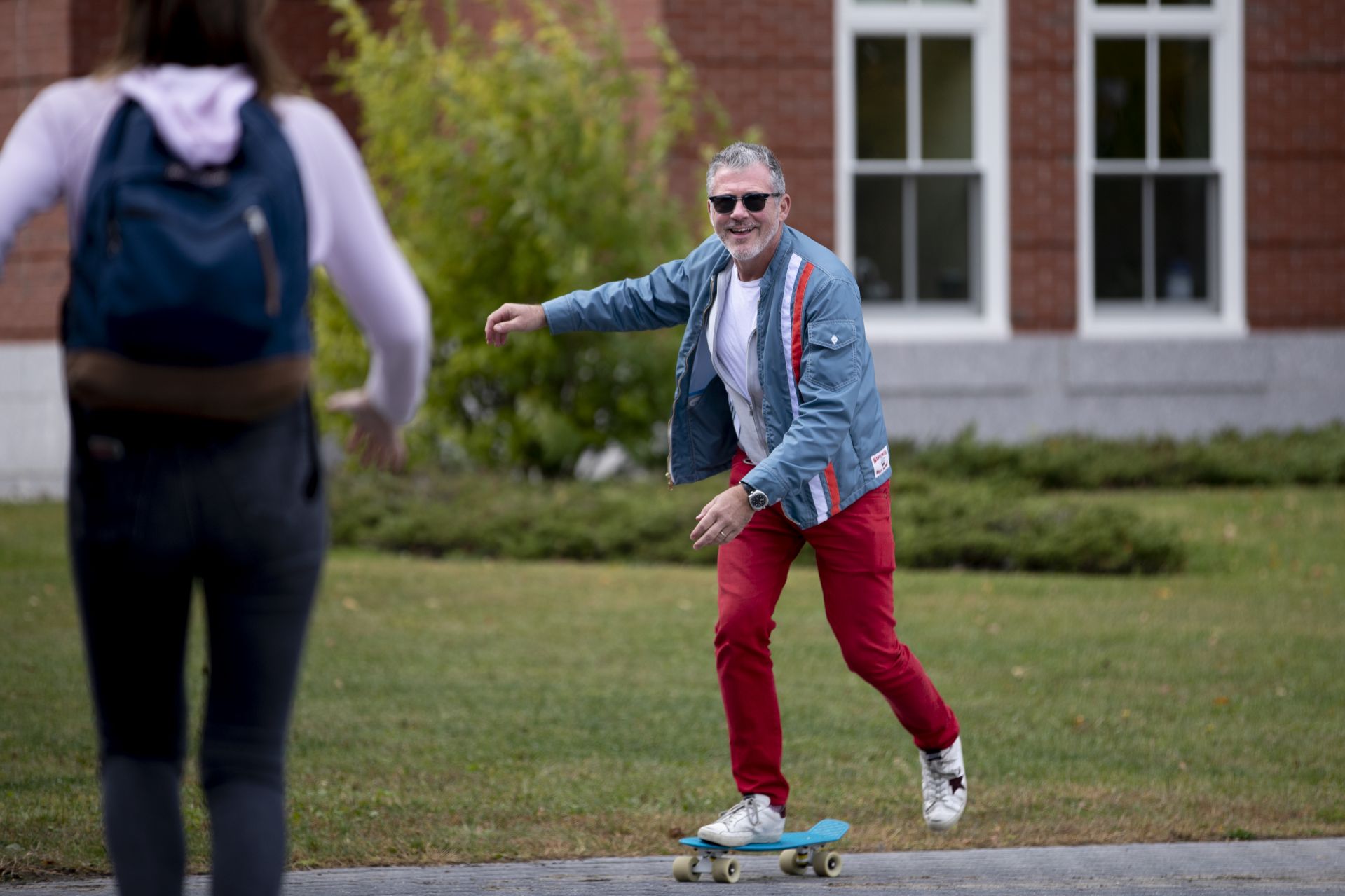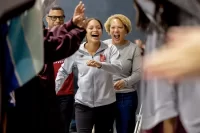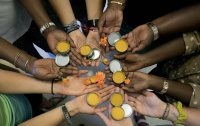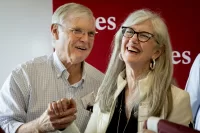
“What? Are you crazy?!”
On a sunny and warm April afternoon last year, Bates photographer Phyllis Graber Jensen chided herself for declining an invitation from Bates rowing coach Peter Steenstra to join him on a boat ride on the Androscoggin River to review his team’s workout.
She was at the boathouse to do team photos, and didn’t think she had the right lenses to shoot rowing. But she quickly reconsidered and hopped aboard. “Sometimes, it’s not too late to change your mind,” she says.
In our sixth annual edition of photographers’ favorites, Graber Jensen and fellow Bates Communications photographer Theophil Syslo share 22 images that they love from 2019 — many of which reflect the “just say yes” mindset of these talented photographers.
Horn Blower
Phyllis Graber Jensen: On a late afternoon in January, I was wandering the Olin Arts Center looking for an Instagram feature when I encountered Julie Jesurum ’22 of Weston, Mass., departing the concert hall after a rehearsal with the Bates Jazz Band. Swallowing my disappointment at the missed opportunity — happens all the time — I asked if she would mind playing for a few additional minutes in service of Bates social media.
She agreed, and we headed to one of the first-floor practice rooms, which, small and spare, don’t add much to a photograph. Plus, I was without a flash. But there were three elements in my favor: Julie, her trumpet, and a Canon 35mm f/1.4 lens, the last of which allowed me to achieve shallow depth of field.
After a few minutes of trying different perspectives, we arrived at this moment, fingers depressing keys, a visual and audible gift from the musician.
Ball at Rest
Theophil Syslo: This photograph shows a lacrosse ball resting in a puddle atop the Garcelon Field turf during a March game against Middlebury. It reminds me of my early curiosity about photography, exploring light and shape and using water and oils to create abstracts in one of my first darkroom classes.
It’s ironic, and maybe a bit humorous, that during a sporting event you could’ve seen me with a giant camera lens — perfect for getting tight shots of blazing fast action — pointed at the ground, at a motionless ball no less.
Window on the Upper West Side
Phyllis Graber Jensen: I love New York. It’s my hometown, so the pleasure intensifies when I visit. This fall, I photographed Jane Costlow, Clark A. Griffith Professor of Environmental Studies, as she presented a paper at a New York University conference, part of my series about Jane’s 34th and final year of teaching at Bates.
This image shows Jane at breakfast with a longtime friend, Ellen Chances, who is a Princeton professor of Russian literature and the daughter of the late Bates economist Ralph Chances and Natasha Chances, who was well-known in Lewiston for her piano teaching.
Whenever Jane’s in New York, the two get together at the Utopia diner (they love the name) on the Upper West Side, where they catch up and rejoice in each other’s company, something that you can see immediately in this image. I sat at an adjacent table with a view of Amsterdam Avenue at the 72nd Street subway station. I was able to photograph at some leisure by ordering tea and toast so the manager wouldn’t chase me out. Scenes from Seinfeld.
Fish and Tell
Theophil Syslo: Sometimes the story behind the photo is better than the photo. In this case, I think they’re both rather awesome, reminding me of the beauty and art found in nature and in life.
Eric Stirling ’97 is the proprietor of West Branch Pond Camps in Maine’s remote Piscataquis County, and he brings understanding, history, care, and knowledge to what he does, all of which made me appreciate the time I spent visiting him and his family.
His confidence that he could land a trout on his first cast off the dock after I asked, “Are there any fish in the pond?” was picture-perfect. It was the old proverb made literal: “Give a man a fish and you feed him for a day; teach a man to fish and you feed him for a lifetime.”
This perspective resonated on a new frequency for me as I visited and photographed Stirling and his camp, where there is no cell phone signal or internet. I could see that his son, who had been there watching us the whole time, was absorbing his father’s way of life and outlook.
Comfort with Discomfort
Phyllis Graber Jensen: When photographing students on their summer internships, I also do brief interviews. On a trip to Washington, D.C., I photographed and interviewed Ellijah McLean ’20 of Providence, R.I., who had a Purposeful Work–funded internship with PeerForward, a nonprofit that connects low-income students to college and careers through positive peer influence.
He talked about being an African American student in a mostly white environment: “I grow most when I’m incredibly uncomfortable, but you have to be comfortable with being uncomfortable,” he said.
For a portrait, he suggested we go to the rooftop of PeerForward’s office, which is in the former Uline Arena, famous for, among other events, the Beatles’ first U.S. performance, in 1964 (when the venue was known as the Washington Coliseum). Now it’s also remarkable as the place where Ellijah, on his 21st birthday, lowered his head as I paused to switch lenses on my camera body. I pressed the shutter and he looked up, ready to continue.
Anticipation
Theophil Syslo: When I’m shooting an assignment, something completely unrelated will sometimes capture my attention. This was one of those cases. I was near Lake Andrews working with Phyllis Graber Jensen to photograph the Bobcat mascot when suddenly a disturbance in the water caught my eye.
Joining the usual mallards and gulls on the Puddle were a few hooded mergansers (I’d seen many in my newspaper work in South Carolina). The Bobcat shoot done, I hustled back to our Lane Hall office, grabbed the longest glass we had, plus an extender, and returned to the Puddle.
I visualized what I wanted: something unpredictable. After sitting and floating for a time, one merganser began to search the shoreline. Then it dove once, and again. I tried to anticipate where it would resurface each time, prefocusing my lens on a spot.
It dove, surfaced where I anticipated — with a crayfish in its beak! — but then a seagull swooped in to steal the bounty. It was all over in a second.
Getting Goofy
Phyllis Graber Jensen: I’ve known Ethan Miller ’99 since his student days, when I photographed him and Matt Schlobohm ’00 as they staffed an environmental summer day camp in Auburn. Now he’s a member of the college’s environmental studies faculty, and I know him as a teacher, scholar, and community citizen who lives on an agricultural collective in Greene, where I photographed him for Doug Hubley’s story about his new book and living sustainably.
One activity that day was harvesting medicinal herbs, and Ethan suggested I try one plant in particular, Spilanthes. I popped a bud into my mouth and felt an explosion of sensation that shocked me with its intensity. Wow. And the next thing I knew, serious and gentle Ethan had shut his eyes and placed flowers onto his closed eyelids. “Just me being goofy,” he reported. He ended up with tingly eyes and a tinge of regret.
Table Leaves
Phyllis Graber Jensen: These leaves won’t accommodate additional family and friends, but they do bring something extra to the table. I have many opportunities to photograph beautiful fall foliage, and have chased the colorful leaves repeatedly throughout the years, but this is the first time I’ve seen this tableau on the terrace outside the Bobcat Den. The rain only enhanced the scene.
Speed of Light
Theophil Syslo: In this photo, a student from Virginia Tech, in Maine on an environmental summer internship, uses light from his phone for a nighttime portrait at the college’s Coastal Center at Shortridge. He told me how he was stunned to see a sky so free of light pollution: “Standing up on that rock and looking at the intricacies of the universe, flushed me with feelings of wonder, astonishment, and excitement.”
Moments like this, the juxtaposition of what we see when we look down to our phones vs. the vastness of what’s up there, cause me to pause and reflect on inner space, outer space, curiosities, wanderings, exploration, and humanity. I’m reminded of who I am and where I came from. But where I am going?
Fireworks in a Box
Phyllis Graber Jensen: Fireworks at Reunion, offered on Friday evening of the three-day event, always dazzle. In 2019, I scouted a new location and decided to use Pettengill Hall as a framing device. As the sky darkened, I set up a tripod on Alumni Walk and waited for the fun to begin. Soon, the reports, the fireworks’ boom, buzz, and hiss, had me mesmerized, along with hundreds of others around Lake Andrews, as I tripped the shutter and watched the explosions over P’gill.
Out of the corner of my eye — or maybe it was one of those eyes in the back of my head — I noticed lights bouncing crazily. I turned around to see reflections of the fireworks in the windows of Hedge Hall. Spinning the tripod, I photographed a delightful surprise.
Happy with the Blues
Theophil Syslo: Can you love an image before taking it? When I saw this photo assignment — organic blueberry farmer Nick Lindholm ’86, the Blue Hill peninsula, summertime, Maine — I immediately thought: “Yes! Please and thank you!”
I really like the gesture and expression Lindholm is making, which, combined with the abstract feel from the reflection in the window, pleases me.
February Melt
Phyllis Graber Jensen: It’s 57 degrees Fahrenheit on Feb. 5 as snowmelt from the roof of Commons cascades onto the top of a wall outside. I had just finished a lunchtime video assignment in Commons and was on my way to photograph a group of Frisbee-tossing students cavorting on Garcelon Field when the splashing water caught my eye.
I strolled over to see what was up, or rather, coming down. Significant underexposure, a slower shutter speed, and maximum depth of field account for turning what I saw into what you see, something altogether different.
The Gray Studio
Theophil Syslo: Not all photography is created the same way. Yes, we click the shutter, and an image appears. But sometimes there is thought, planning, creativity, and visualization way before we click the shutter.
In this instance, we wanted to create “one-minute portraits” at this year’s Trashion Show. So, how do we achieve this? The answer: In the Gray Athletic Building — the site of the annual fashion show where students don outfits made from campus trash — create a photo studio where each participant can strike a pose or two in just a minute.
In this photograph, the model and her designers are members of the women’s track team. The outfit is made from back issues of The Bates Student. What I like about the image is its readability — pun intended — that draws your eye from face to face and then back again to the beginning, only to start over again.
They’re all engaging with the outfit, in a sense reading the story of the 2019 Trashion Show.
River Dream
Phyllis Graber Jensen: On April 25, I drove out to the Traquina Boathouse in Greene to take pictures of the rowing teams. I decided to travel “lens light” and brought only one moderate wide to short telephoto zoom lens, along with some strobe lights in case I needed them.
After photographing the men’s and women’s teams, rowing coach Peter Steestra invited me to go out on the water with him as the athletes squeezed in a last practice before the annual President’s Cup, the Bobcats’ signature home regatta vs. Bowdoin and Colby, three days hence. “No, thanks,” I replied. “I don’t have the right equipment.”
By the time I reached my car, I had come to my senses. “What? Are you crazy?” I thought. Even without a camera, I’d be nuts to turn down an opportunity to spend time on a gorgeous stretch of the Androscoggin River on a warm, sunny afternoon.
I turned on a dime and trotted back to the dock, where Peter offered me a second chance. “It’s a dream,” he said of the team’s home and the day’s delightful conditions. Sometimes, it’s not too late to change your mind.
Light Work
Theophil Syslo: Immersing myself in a lively Bates classroom fuels my fire and helps support my goal of contributing to something greater than myself. (This was a Short Term course taught by practitioner Elly Rostoum ‘07 about intelligence work, so I also love the idea that I can now use the words “CIA” and “documentation” in the same sentence.)
I like how the light is at play, beaming through the tall windows of historic Hathorn Hall with a brilliant softness, unlike the artificial light that unkindly bathes students and faculty in other classrooms. I also like the photograph’s readability — the animated faces and lively gestures of the students and teacher — the spectrum of the conversation and moment frozen in time.
Pasta Downpour
Phyllis Graber Jensen: Here’s another event I attend every fall: the kickoff for AESOP, the fabled three-day student-led trips during Orientation. Traditionally, the program’s trip coordinators introduce themselves in an official welcome at Lake Andrews’ Keigwin Amphitheater, then scores of AESOP trip leaders, dressed in crazy costumes, descend upon the gathering of unsuspecting first-years to pelt the coordinators with all kinds of substances.
This year, I heard they would be toning it down a bit, so I wondered what to expect. The leaders lined up behind the coordinators — Erni Whitaker, Grace Warder, and Peter Griffin — and doused them with a mix of water, pasta, eggs, and glitter. The camera stopped the action in a way that I never really saw through the camera’s viewfinder. It was a happy discovery when I edited the shoot to find this moment.
Sunrise, Sunset
Theophil Syslo: Some photographs grow on you over time: The longer you look at them, the more you see. As my eyes swim through this frame, I begin to notice small silhouettes of humans along the rock formations. Who are they? What are they doing? Where are they going?
They’re Bates’ newest students, participating in an AESOP outdoor trip during Orientation to Hermit Island Campground in Phippsburg, Maine, near the Bates–Morse Mountain Conservation Area.
In a larger context, they’re also young adults beginning the first chapter of their new lives. We all think about beginnings and endings, how our day begins and how our day ends, what’s coming and what’s happened. As the sun set, we shared ice cream and stories, and I felt their anxious optimism for tomorrow and the coursework to follow.
High on the Hammock
Phyllis Graber Jensen: Two things I never thought I’d see on campus when I started working at Bates in 1995: students talking on cell phones, and students lounging in hammocks. Now, both are ubiquitous, the latter far more photo-worthy.
At the first hint of mild weather in any season, hammocks appear like clockwork with their occupants studying, snuggling, or sleeping. You’d think you were on a hammock farm. Novel at first, they’re now as common as squirrels or water bottles.
Although I enjoy hammocks and their swingers, I can only photograph so many of them. What drew me to this hammock was its height, its occupant appearing enthroned royally above Alumni Walk, like a Prince of Sway. His sock-covered feet, no shoes in sight, are gravy.
Child’s Eye View
Theophil Syslo: I like how this photograph reflects a moment: a simple gesture between Bates student-athletes and a child. The child is 6-year-old Brayden Austin, who was an honorary captain of this year’s football team. As his mom said, “He may not understand the ins and outs of the game, but he knows how amazing it is to be a part of the team.”
I wanted to show what it might’ve felt like from Brayden’s perspective, so I shot the photographs from Brayden’s height, follow-focusing on him while he walked onto Garcelon Field with his team for the coin flip before their game with Middlebury. To me, everything that is important in the frame is on Brayden’s face.
Bobcat Bouncer
Phyllis Graber Jensen: I suppose Friday afternoons produce unexpected behavior in any workplace. This was one of those times in the Bates Communications Office. Not to ruin it for anyone who believes in the Bobcat, but the BCO had the mascot costume on loan in our Lane Hall quarters for some upcoming photography.
And we had Bates Magazine editor and editorial director Jay Burns, an avowed introvert yet with a penchant for performance, grab the Bobcat head and circulate through the office to celebrate another distribution of the weekly BatesNews email digest that he masterminds. What better place for a Burns portrait in relaxation than in front of an elegant display of Bates Magazine covers in the office’s foyer.
Dodging the Image
Theophil Syslo: A student-faculty dodgeball game for a local food pantry was fun both to shoot and get creative with the frame. It was also one of those assignments where you’d like to put the lens down, pick up a ball, and jump into the game! But I couldn’t, so instead I tried to take the viewer into the mix, to experience what I was seeing and feeling.
That meant putting myself between the two teams. Were my palms sweaty? Probably — but whose wouldn’t be when that young man has on his game face while whipping the ball? I wanted my photo to reflect that I was “trying” just as hard to be good at my game, photography, as he is at flinging dodgeballs at the opposing team.
Daddy Boarder
Phyllis Graber Jensen: It was all about the color. Exiting Roger Williams Hall on the Friday morning of Back to Bates weekend, I first noticed the red pants, then the aqua skateboard, and finally the salt and pepper hair. It all felt like a disconnect, but at my age I can ill-afford having an ageist reaction to anything. Plus, this guy really looked cool and in control.
I grabbed a couple of shots from a distance but then chased after him for caption information and to ask if I could photograph him again. He was Josh Brower, a Bates father visiting from Seattle. He set off again on the skateboard, and once he did, his daughter, Eliza Brower ’22, spotted him as she exited Commons.
She was not excited to see her dad using her board in public. Thrilled to have her in the frame, I felt a surge of schadenfreude: I was not the only parent to have embarrassed my child.
